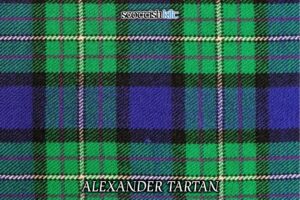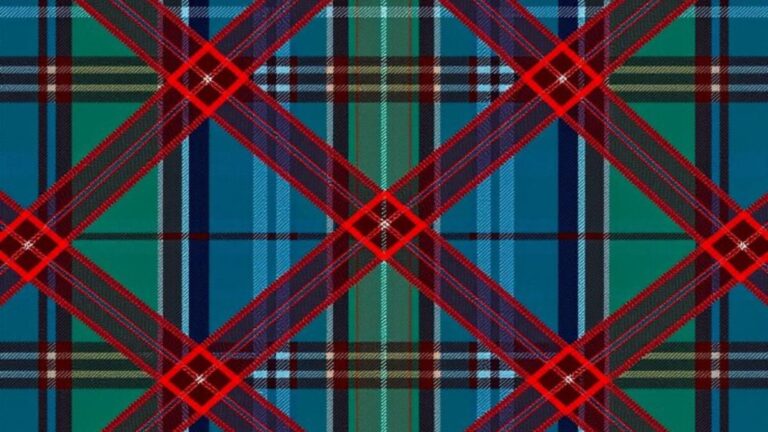The Alexander Clan Tartan is more than just a pattern; it’s a vibrant symbol of Scottish heritage that resonates deeply with kilt enthusiasts around the world. This iconic tartan, with its rich history, distinctive design, and cultural significance, has captivated those who appreciate the blend of tradition and style. Whether worn at Highland Games, cultural festivals, or simply as a proud expression of clan identity, the Alexander Clan Tartan stands out as a timeless choice. Its enduring appeal lies not only in its aesthetic qualities but also in the deep connections it fosters to Scottish history, making it a favored option for those looking to honor and celebrate their roots in a meaningful way.

Historical Significance of the Alexander Clan Tartan
The Alexander Clan Tartan carries with it a profound historical significance that dates back to the 13th century. The Alexander clan, originating from the medieval Scottish Highlands, played a prominent role in the history of Scotland. The clan’s lineage includes notable figures such as Alexander II and Alexander III, who were influential monarchs during their reigns. The tartan itself reflects the clan’s storied past, evolving from its early designs to become a symbol of pride and tradition. In medieval Scotland, tartans were more than just fashion statements; they represented clan affiliations and were used to distinguish different groups. The Alexander tartan, with its distinctive pattern and colors, became a mark of identity for the clan members. As Scottish society evolved, so did the tartan, adapting to changing tastes while preserving its historical roots. Today, the Alexander Clan Tartan remains a living testament to the clan’s heritage, celebrated in various forms from historical reenactments to modern Scottish festivals. The preservation of this tartan is also a reflection of the broader Scottish effort to maintain and celebrate their cultural identity. Various historical records and genealogical studies trace the Alexander tartan’s evolution, highlighting its importance not just as a piece of fabric but as a symbol of a proud heritage. This historical depth adds layers of meaning to the tartan, making it a cherished choice for those who value both history and tradition.
Unique Design and Color Palette
The Alexander Clan Tartan is renowned for its unique design and color palette, which contribute to its enduring appeal. The tartan typically features a combination of dark green, navy blue, and rich red stripes arranged in a balanced and harmonious pattern. These colors were chosen for their traditional association with Scottish tartans and their ability to complement each other aesthetically. The design of the Alexander tartan is a reflection of the clan’s identity and values. The dark green symbolizes the lush landscapes of the Scottish Highlands, while the navy blue represents loyalty and steadfastness. The rich red adds a touch of vibrancy and pride, making the tartan not only a representation of the clan’s heritage but also a statement of elegance and style. The intricacy of the tartan’s pattern involves a careful arrangement of horizontal and vertical stripes, creating a grid-like design that is both visually striking and timeless. This design has been meticulously crafted to ensure that it retains its classic appeal while remaining adaptable to modern fashion trends. In modern usage, the tartan’s design lends itself to a variety of garments and accessories, from traditional kilts to contemporary jackets and scarves. The color palette’s versatility means that the tartan can be integrated into different styles and occasions, making it a popular choice for both formal events and casual wear.
Cultural Relevance and Clan Pride
Wearing the Alexander Clan Tartan is a profound way to express cultural pride and connection to Scottish heritage. For members of the Alexander clan, the tartan represents a tangible link to their ancestors and a source of personal and collective identity. Clan pride is an integral part of Scottish culture, and the tartan serves as a symbol of this pride. The cultural relevance of the Alexander Clan Tartan is evident in various Scottish traditions and ceremonies. It is commonly worn at clan gatherings, historical reenactments, and cultural festivals, where it not only celebrates the clan’s history but also fosters a sense of unity among its members. The tartan’s presence at such events highlights its role in maintaining and promoting Scottish cultural practices. Additionally, the tartan is often featured in genealogical and historical publications, emphasizing its importance as a marker of Scottish heritage. By wearing the Alexander Clan Tartan, individuals honor their lineage and contribute to the preservation of Scottish traditions. This cultural significance extends beyond personal wear, influencing how the tartan is used in various media and public displays to celebrate Scottish identity.
Versatility in Modern Fashion
The Alexander Clan Tartan has demonstrated remarkable versatility in modern fashion, seamlessly blending traditional elements with contemporary trends. Its classic design allows it to be adapted into various garments and accessories, making it a popular choice for those looking to incorporate a touch of Scottish heritage into their wardrobe. In recent years, the tartan has been featured in a range of fashion items, from formal kilts to casual shirts and stylish scarves. Designers have embraced the tartan’s traditional appeal while infusing it with modern flair, creating pieces that appeal to both traditionalists and contemporary fashion enthusiasts. The tartan’s adaptability ensures that it remains relevant in an ever-changing fashion landscape. The versatility of the Alexander Clan Tartan also extends to its use in different types of events. It is equally suitable for formal occasions such as weddings and ceremonial events, as well as for everyday wear. This adaptability is a key factor in its continued popularity, allowing individuals to express their Scottish heritage in a variety of contexts.
Popularity at Highland Games and Festivals
The Alexander Clan Tartan enjoys considerable popularity at Highland Games and Scottish festivals, where it is often worn by participants and attendees alike. These events celebrate Scottish culture and traditions, providing a platform for showcasing various tartans and clan affiliations. Highland Games, with their focus on traditional sports and cultural activities, offer a prime opportunity for the Alexander Clan Tartan to shine. Participants in events such as caber tossing and tug-of-war often wear the tartan as part of their traditional attire, demonstrating their connection to Scottish heritage. The tartan’s visibility at these events underscores its importance as a symbol of clan pride and cultural continuity. Scottish festivals, including music and dance events, also feature the Alexander Clan Tartan prominently. Attendees often wear the tartan to show their support for their heritage and to participate in the celebration of Scottish culture. The tartan’s presence at these festivals highlights its role in promoting and preserving Scottish traditions.
Craftsmanship and Quality
The craftsmanship and quality of the Alexander Clan Tartan contribute significantly to its appeal among kilt enthusiasts. Crafted from high-quality wool, the tartan is designed to be both durable and comfortable, ensuring that it remains a reliable choice for various types of garments. The production of the tartan involves a meticulous process, from selecting the finest wool to weaving the intricate pattern. Skilled artisans use traditional techniques to create a fabric that retains its vibrant colors and intricate design over time. This attention to detail ensures that the tartan remains a premium product, valued for both its appearance and longevity. In addition to its visual appeal, the tartan’s quality extends to its practicality. The wool used in its production is chosen for its ability to provide warmth and comfort, making it suitable for wear in various weather conditions. This combination of craftsmanship and quality ensures that the Alexander Clan Tartan is a worthwhile investment for those seeking a durable and stylish garment.
Symbolism and Heritage
The Alexander Clan Tartan is imbued with symbolic significance, reflecting various aspects of Scottish heritage and clan identity. Each element of the tartan’s design represents different values and traditions associated with the clan and Scottish culture. The colors of the tartan are rich in symbolism. Dark green is often associated with the lush landscapes of Scotland, representing a connection to the natural environment. Navy blue signifies loyalty and steadfastness, qualities that are highly regarded in Scottish tradition. The rich red adds a sense of vibrancy and pride, highlighting the clan’s strength and heritage. The tartan’s pattern itself is symbolic of the clan’s history and values. The carefully arranged stripes and checks are not merely decorative; they reflect the clan’s structure and identity. Wearing the tartan is a way to honor these symbols and maintain a connection to the clan’s legacy.
Influence of Popular Culture
Popular culture has played a significant role in the tartan’s popularity, with the Alexander Clan Tartan appearing in various media and entertainment forms. Films, television shows, and literature that explore Scottish history and culture often feature tartans as a way to enhance the authenticity of their settings. The tartan’s appearance in popular media has contributed to its visibility and appeal. By showcasing the Alexander Clan Tartan in films and shows, creators have introduced it to a broader audience, increasing its recognition and desirability. This influence extends to fashion trends, where the tartan’s presence in popular culture helps to reinforce its status as a fashionable and iconic choice. In addition to media, the tartan’s influence is also seen in merchandise and memorabilia. Items featuring the Alexander Clan Tartan, such as scarves and accessories, are popular among fans of Scottish culture and history. This connection to popular culture further enhances the tartan’s appeal and relevance.

The Timeless Appeal of Kilts
Kilts are a quintessential symbol of Scottish heritage, celebrated for their rich history and distinctive style. Traditionally worn by men, kilts are characterized by their pleated tartan fabric, which is meticulously crafted and often associated with specific Scottish clans. Over the years, kilts have evolved from their historical origins into a versatile garment that bridges the gap between tradition and contemporary fashion. Whether worn at formal events, Highland Games, or as part of everyday attire, kilts embody a sense of cultural pride and identity. Their enduring popularity is a testament to their unique blend of craftsmanship, heritage, and stylish versatility, making them a cherished and iconic element of Scottish culture.
Customization and Personalization
The Alexander Clan Tartan offers a range of customization and personalization options, allowing enthusiasts to tailor their garments to their preferences. Whether for a special occasion or everyday wear, individuals can choose from various styles and accessories to create a unique look. Customization options include selecting different types of garments, such as kilts, jackets, and accessories, all made from the Alexander tartan. Additionally, enthusiasts can choose from various design elements, such as fringe styles and button types, to create a personalized piece that reflects their individual taste. Personalization also extends to embroidery and monogramming, allowing individuals to add personal touches to their garments. This level of customization enhances the tartan’s appeal, making it a versatile choice for those looking to make a distinctive statement while honoring their heritage.
Enduring Appeal and Legacy
The enduring appeal of the Alexander Clan Tartan is a testament to its rich history and timeless design. As a symbol of Scottish heritage, it continues to attract kilt enthusiasts who appreciate its traditional roots and modern versatility. The tartan’s legacy is preserved through its continued use and appreciation. It remains a cherished part of Scottish culture, celebrated for its historical significance and aesthetic appeal. The ongoing popularity of the tartan ensures that its legacy endures, connecting new generations with their heritage and traditions. In summary, the Alexander Clan Tartan’s popularity among kilt enthusiasts is a reflection of its historical significance, unique design, and cultural relevance. Its ability to blend tradition with modern fashion, coupled with its symbolic value, makes it a favored choice for those who wish to celebrate and honor Scottish heritage. The tartan’s enduring appeal and legacy ensure that it remains a cherished symbol of Scottish pride and tradition.
Conclusion
The Alexander Clan Tartan continues to be a popular choice among kilt enthusiasts, embodying a rich tapestry of history, culture, and timeless design. Its appeal lies in its ability to seamlessly blend traditional Scottish heritage with modern fashion, offering a versatile and meaningful way to express clan pride and identity. Whether worn at cultural events, family gatherings, or as part of everyday attire, this tartan stands as a powerful symbol of the enduring legacy of the Alexander clan. Its unique design, coupled with its deep historical roots and cultural significance, ensures that the Alexander Clan Tartan remains a cherished and iconic piece of Scottish fashion, resonating with those who value tradition, craftsmanship, and a connection to their ancestral heritage. As it continues to inspire and captivate new generations, the Alexander Clan Tartan’s legacy is set to endure, honoring the past while remaining a vibrant part of the present and future of Scottish culture.
